Microsoft BUILD: Windows 8, A Pre-Beta Preview
by Brian Klug & Ryan Smith on September 13, 2011 12:05 PM EST- Posted in
- BUILD
- Windows
- Microsoft
- Windows 8
- Trade Shows
The Technical Side Of Windows 8: Cont
Moving up the chain, Microsoft has added a number of base class drivers for hardware in Windows 8. This includes not only USB 3, but also class drivers for mobile broadband radios, sensors, and even printers. For printers this means Windows 8 can print to roughly 70% of all Windows 7 certified printers without an additional driver, which is nearly a necessity for Windows 8 as an ARM tablet OS, as drivers may not be available and tracking down a driver flies in the face of the modern pre-configured OS model for tablets.
For mobile broadband things are a bit more interesting. With this addition mobile broadband is being promoted to a first class connectivity option, right up there with Wi-Fi and Ethernet. Mobile broadband hardware can then be integrated into a laptop or a tablet or added via a dongle without requiring a driver or a complex dialer/manager application. Managers will still exist in a lesser form as a Metro application; Microsoft included one such example with the tablet we tested, which had a working AT&T 3G modem and its associated management application.

Windows 8 will also be aware of the limitations of mobile broadband connections, with an emphasis in usage caps. Given appropriate information by the ISP Windows 8 knows to halt background download processes (e.g. Windows Update, weather updates, RSS) to keep them from consuming valuable bits, and to notify the user if the device is approaching the cap and would be subject to overages. Along these lines Windows 8 also knows to switch to another source (i.e. Wi-Fi) when it’s available to avoid using up those metered bits.
We’ve mentioned permissions before when talking about the Windows Store, but it seems prudent to mention it again. For Metro applications Windows 8 will have a more fine grained permissions model than existing low/user/admin level privileges, by implementing Android style permissions. Metro applications will only be able to access the resources and data they were approved for, reducing the ability for a compromised application to be used as a launch pad for further attacks.
Our next stop on our look at the technical details for Windows 8 is the boot process. Microsoft put up an interesting blog last week discussing Windows 8’s new boot process, which was reiterated here – Windows 8 boots up much faster than Windows 7 thanks to the fact that only user processes are shut down, meanwhile the kernel is hibernated rather than shut down, shaving off a lot of time that would be needed to reload the kernel from a fresh boot. Realistically you need a motherboard with a very fast POSTing sequence, which means this is best paired with UEFI-based OEM boards. Certainly self-built systems will improve too, but we would not expect by as much.
The other new fact discussed about the Windows 8 boot process was that Microsoft is making another push to secure it through chain of trust hardware (presumably a TPM module), this time under the name Secure Boot. Utilizing the chain when available, if Windows 8 detects that a boot component has been modified it will fail the boot and kick over to the Windows Recovery Environment to restore the OS to a fixed state. With ARM devices (and even most PC tablets) the use of this feature will be a given, but obviously TPM hardware is much rarer on laptops and desktops.
Windows’ anti-malware features will also be making an appearance in the boot process. Windows Defender (which now includes Microsoft Security Essentials) now loads immediately after the critical boot components are loaded, allowing Defender to check everything that wasn’t protected by the Secure Boot process above.
Finally when it comes to booting, the last bastion of the CLI in the Windows boot process is gone. The F8 menu has been replaced with a GUI based Windows Recovery Environment. The WRE goes hand in hand with two other recovery features: Refresh and Reset.
Reset is a Windows-based implementation of OEM OS recovery partitions: when Reset is triggered, the entire system is overwritten by the restoration copy. As for Refresh it’s a bit more nebulous; it’s apparently a new implementation of Windows’ existing Last Known Good Configuration, allowing users to revert anything crapware may have done. But we don’t have the full details on its underpinnings at this time.

Last, but certainly not least we have the Task Manager. Other than a couple of minor changes with Windows Vista the Task Manager has remained nearly unchanged for years, so of course Microsoft has gone ahead and overhauled it. By default the new Task Manager is extremely simplified and only lists running user applications, thereby ensuring users only close applications and not background processes and such by mistake.
In detailed most the Task Manager takes on a more traditional appearance, giving you greater details about all of the running processes (including breaking them down by application or background process), but also a number of new performance metrics (largely taken from Windows 7’s performance monitor), and even an over-time breakdown of the resource usage of all of the system’s installed Metro applications. Interestingly the Task Manager itself is not strictly Metro, but rather a desktop application that doesn’t require the desktop environment to be loaded.


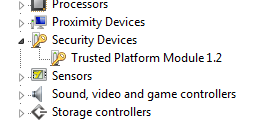
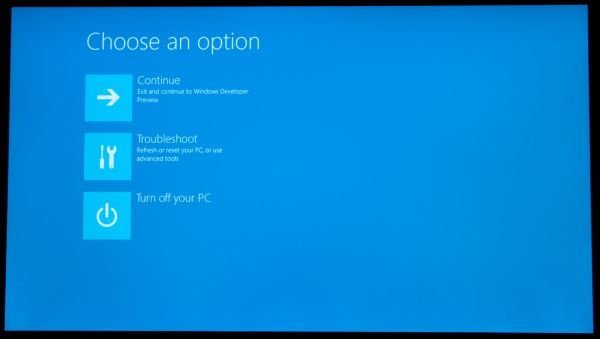
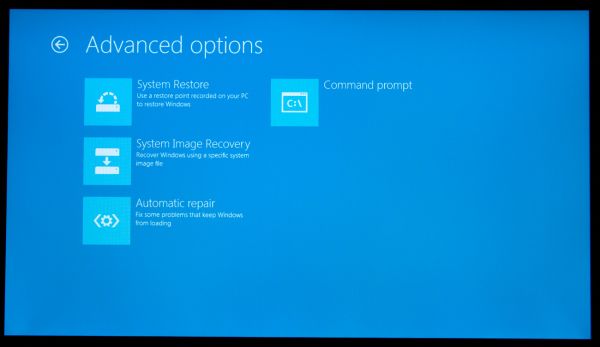
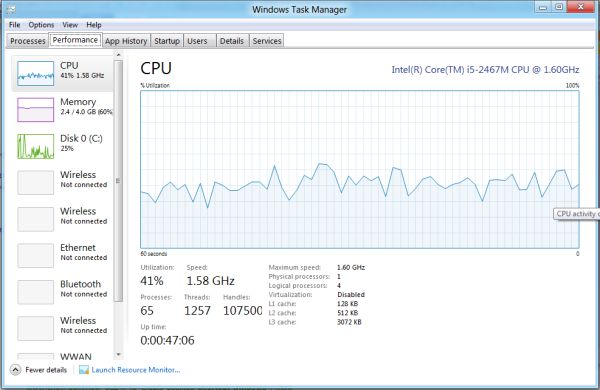
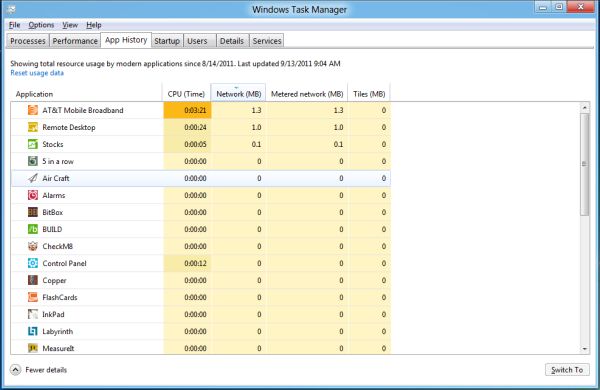








235 Comments
View All Comments
cldudley - Thursday, September 15, 2011 - link
I see these arguments all the time about the application that use the ribbon-based UI, but I don't really see the problem... The most common features are located obviously and are easy to find, what are you using that is inconvenient? Mail-merge maybe, or something less obvious?I put together plenty of spreadsheets and documents using Excel/Word 2010, and I have used AutoCAD 2011 pretty extensively too, and I have no problem with the ribbon.
Maybe I am not doing the tasks you are doing, I write software for specialized controllers, produce drawings and layouts for industrial electrical control equipment, plus write documentation, memos, various tables and schedules, etc. At home I write letters, do the budget, different types of software development, game, etc, and I do not have any of these complaints.
I think the reality for 99.9999% of people is just the curmudgeon factor. "It's not what I am used to, so I don't like it."
gmknobl - Tuesday, September 13, 2011 - link
It appears MS is going for a real sea change here. What's hidden may not be either evolutionary or revolutionary but the GUI appears revolutionary, and that's not necessarily good.If they keep this to tablets only, they'll have to have a big hardware push at the same time and NO issues. In other words, a system that works as well or better than iOS from the start or they are in trouble in the tablet space. However, I think this is their best bet.
But as it stands now, if this isn't an easily disabled option for business and home non-tablet, non-phone computing it will fail in that area completely. One thing Apple got right with their OSes has been usability. (I think Amiga did too back in the day, and Android has now too.) MS has taken around three tries before it got a truly usable OS each time, including Win 7 which is essentially Vista SP2. They can't afford that this time. I cannot see this succeeding with desktops or laptops in the least. It's just too jarring, now matter how innovative it may be.
And I think the whole solid color flat 2d look is dead anyway but that's personal preference.
avddreamr - Tuesday, September 13, 2011 - link
While this format can and does work adequately in a mobile or rather hand held format the compromises that are made for this sort of functionality are simply unacceptable.I hope that this is obvious, because if that's the UI I have to deal with day to day... I will either not upgrade, switch to penguineware, or go fruity.
I would hope that with the vast collection of talent that works for microsoft have to know that the ui should be tailored for its specific use. Give me a 3d-taskbar, with scalable icons, and I'll be happy with the progress in my desktop.
I tell myself that they can't honestly be this stupid... but then I remember windows millennium.
CrapONez - Tuesday, September 13, 2011 - link
I'm at a loss to see how/why Microsoft would abandon a legion of business customers and introduce a new interface requiring retraining, from a mobile device paradigm that it owns a scant few percentage points of. As Kelly Bundy would say: "It wobbles the mind!"alent1234 - Tuesday, September 13, 2011 - link
do companies really spend a lot of money on OS training?damianrobertjones - Tuesday, September 13, 2011 - link
No they don't.Here is the training for Metro
"Do you see the massive Window for Icon there in purple... click it"
Opens Excel in the standard fashion.
"Do you see the saved excel spreadsheet there, right click and attach to the desktop/ui"
User scrolls tyo his/her Excel files.
User... "Ohh that's shiny"
cldudley - Thursday, September 15, 2011 - link
This. I have never had any computer "training" other than sitting down in front of the machine and using it.I may consult the online help quite a lot at first, but after I get used to how things work it all kind of comes together on it's own.
Certainly no employer has ever given me a training class for applications, in 2011 it is just assumed you know how to operate a Windows-based computer and basic Office applications. I don't think there is anything wrong with this assumption.
jecs - Tuesday, September 13, 2011 - link
Ok, tablets, I can see and understand.But do I have to pay full price for a tablet shell on a desktop or a workstation? And if W8 is mostly an interface would MS consider W8 a service pack for desktop use?
I want to skip W8 shell on my desktop, but I may like or need W8 other upgrades at a "fair" reduced price.
If MS does not understand this I wont pay for W8. Lets hope the best for W9.
damianrobertjones - Tuesday, September 13, 2011 - link
They offered Windows 7 at a reduced pricedgingeri - Tuesday, September 13, 2011 - link
It looks a lot like the old Star Trek LCARS system. Sure, LCARS was imaginary for the most part, but the guys who came up with it back when Star Trek: The Next Generation was in pre-production had the same basic ideas behind their design. I'm thinking Paramount might have an nice IP case against Microsoft for this one.